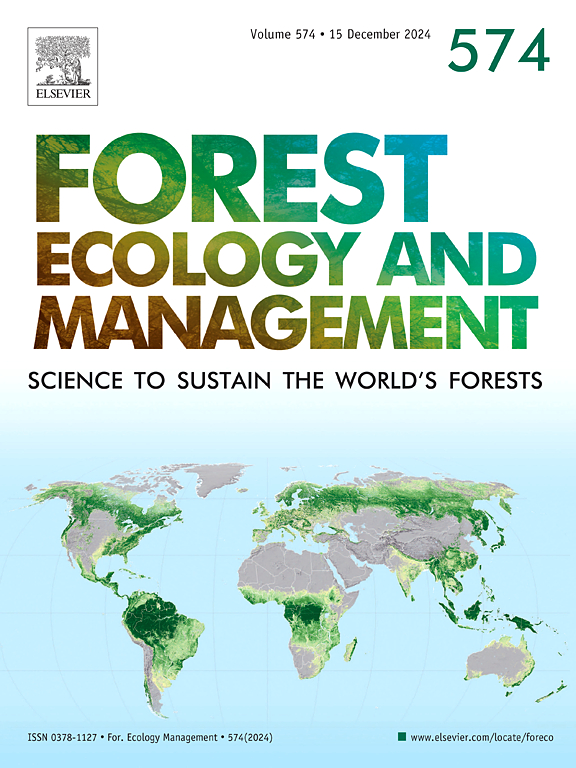环境变量对灰枯病介导的树木死亡和落叶的影响
IF 3.7
2区 农林科学
Q1 FORESTRY
引用次数: 0
摘要
欧洲白蜡树(Fraxinus excelsior L.)种群受到入侵真菌Hymenoscyphus fraxineus (T.Kowalski) Baral, Queloz &;细谷,造成巨大的景观变化和公共安全风险。了解季节性气候和疾病严重程度之间的相互作用可以为整个欧洲灰烬林地的针对性虫害管理提供有价值的信息。我们汇编了80篇关于欧洲白蜡树枯梢病爆发的同行评议论文,获得了681棵树木死亡记录和1078棵树冠损害测量数据,这些数据与地理参考气候变量有关。虽然环境变量与树木死亡率没有显著相关性,但我们观察到春季平均温度(3 - 5月)为13°C,夏季最高温度(6 - 8月)为25°C时,树木死亡率最高。春季和夏季较高的温度与较低的落叶显著相关。夏季降水显著增加了树木的落叶量,而春季降水对树木的落叶量影响不显著。这些结果将促进树木疾病预测,提供证据,使更有效的疾病缓解战略成为可能。本文章由计算机程序翻译,如有差异,请以英文原文为准。
The impact of environmental variables on ash dieback mediated tree mortality and defoliation
Populations of European ash (Fraxinus excelsior L.) are threatened by an invasive fungus, Hymenoscyphus fraxineus (T.Kowalski) Baral, Queloz & Hosoya, causing substantial landscape changes and risks to public safety. Understanding the interplay between seasonal climate and disease severity can provide valuable information for targeted pest management of ash woodlands across Europe. We compiled 80 peer-reviewed papers on the outbreak of European ash dieback, obtaining 681 tree mortality records and 1078 crown damage measurements with geo-referenced climatic variables. While none of the environmental variables exhibited a significant correlation with tree mortality, we observed peak mortality rates at an average spring temperature (March–May) of 13 °C and a maximum summer temperature (June–August) of 25 °C. Higher spring and summer temperatures were significantly associated with lower defoliation. Summer precipitation significantly increased the defoliation levels, while spring precipitation does not have a significant effect on tree deflorations. These results will facilitate tree disease forecasting, providing evidence that will enable more effective disease mitigation strategies.
求助全文
通过发布文献求助,成功后即可免费获取论文全文。
去求助
来源期刊

Forest Ecology and Management
农林科学-林学
CiteScore
7.50
自引率
10.80%
发文量
665
审稿时长
39 days
期刊介绍:
Forest Ecology and Management publishes scientific articles linking forest ecology with forest management, focusing on the application of biological, ecological and social knowledge to the management and conservation of plantations and natural forests. The scope of the journal includes all forest ecosystems of the world.
A peer-review process ensures the quality and international interest of the manuscripts accepted for publication. The journal encourages communication between scientists in disparate fields who share a common interest in ecology and forest management, bridging the gap between research workers and forest managers.
We encourage submission of papers that will have the strongest interest and value to the Journal''s international readership. Some key features of papers with strong interest include:
1. Clear connections between the ecology and management of forests;
2. Novel ideas or approaches to important challenges in forest ecology and management;
3. Studies that address a population of interest beyond the scale of single research sites, Three key points in the design of forest experiments, Forest Ecology and Management 255 (2008) 2022-2023);
4. Review Articles on timely, important topics. Authors are welcome to contact one of the editors to discuss the suitability of a potential review manuscript.
The Journal encourages proposals for special issues examining important areas of forest ecology and management. Potential guest editors should contact any of the Editors to begin discussions about topics, potential papers, and other details.
 求助内容:
求助内容: 应助结果提醒方式:
应助结果提醒方式:


